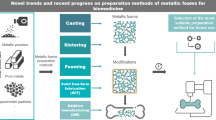Abstract
Introduction
Porous structures already have a wide range of applications in almost every modern sector of science, from catalysis to structural applications. Due to the possibility to easily tailor porosity and mechanical properties, porous structures also found application in the orthopaedic field, in particular to improve osteointegration properties of implants.
Discussion
Different techniques were developed or adapted to obtain a good combination of mechanical strength, pore dimensions and Young’s modulus, without neglecting biocompatibility and corrosion resistance. The aim of this work is to summarise and compare the most important characteristics of the technologies currently used for the production of commercial orthopaedic porous structures.
















Similar content being viewed by others

References
Weber JN, White EW (1972) Carbon-metal graded composites for permanent osseous attachment of non-porous metals. Mater Res Bull 7(9):1005–1016
Robertson DM, Pierre L, Chahal R (1976) Preliminary observation of bone ingrowth into porous materials. J Biomed Mater Res 10:335–344
Turner IG (2009) Biomedical materials. In: Narayan R (ed) Glasses and glass ceramics. Springer, New York
Lu JX, Flautre B, Anseelme K, Hardouin P, Gallur A, Descamps M, Thiery B (1999) Role of interconnections in porous bioceramics on bone recolonisation in vitro and in vivo. J Mater Sci Mater Med 10:111–120
Jacobs JJ, Gilbert JL, Urban RM (1998) Corrosion of metal orthopaedic implants. J Bone Joint Surg Am 80:268–282
Pizoferrato A, Vespucci A, Ciapetti G, Stea S (1985) Biocompatibility testing of prosthetic implant materials by cell cultures. Biomaterials 6(5):346–351
Ryan G, Pandit A, Apatsidis DP (2005) Fabrication methods of porous metal for use in orthopaedic application. Biomaterials 27:2651–2670
Levine B (2008) A new era in porous metals: applications in orthopaedics. Adv Eng Mater 10:788–792
Marin E, Fusi S, Pressacco M, Paussa L, Fedrizzi L (2010) Characterization of cellular solids in Ti6Al4V for orthopaedic implant applications: trabecular titanium. J Mech Behav Biomed Mater 3:373–381
Lefebvre LP, Banhart J, Dunand DC (2008) Porous metals and metallic foams: current status and recent developments. Adv Eng Mater 10(9):775–787
Takemoto M, Fujibayashi S, Neo M, Suzuki J, Kokubo T, Nakamura T (2005) Mechanical properties and osteoconductivity of porous bioactive titanium. Biomaterials 26:6014–6023
Lugscheider E, Lu P, Hauser B, Jager D (1987) Optimized vacuum plasma-sprayed titanium coatings. Surf Coat Technol 32:215–226
Parthasarathy J, Starly B, Raman S, Christensen A (2010) Mechanical evaluation of porous titanium (Ti6Al4V) structures with electron beam melting (EBM). J Mech Behav Biomed Mater 3:249–259
Harrysson LA, Censizoglu O, Marcellin-Little DJ, Cormier DR, West HA II (2008) Direct metal fabrication of titanium implants with tailored materials and mechanical properties using electron beam melting technology. Mater Sci Eng C 28:366–373
Manley MT, Kotzar G, Stern LS, Wilde A (1987) Effects of repetitive loading on the integrity of porous coatings. Clin Orthop Relat Res 217:293–302
Boccaccini AR, Ondracek G, Mombello E (1996) Determination of stress concentration factors in porous materials. J Mater Sci Lett 15:534–536
Frosh KH, Barvencik F, Viereck V, Lohmann CH, Dresing K, Breme J, Brunner E, Sturmen KM (2004) Growth behavior, matrix production, and gene expression of human osteoblasts in defined cylindrical titanium channels. J Biomed Mater Res 68A(2):325–334
Reclaru L, Eschler PY, Lerf R, Blatter A (2005) Electrochemical corrosion and metal ion release from Co–Cr–Mo prosthesis with titanium plasma spray coating. Biomaterials 26:4747–4756
Reclaru L, Lerf R, Eschler PY, Blatter A, Meyer Pitting JM (2002) Crevice and galvanic corrosion of REX stainless-steel/CoCr orthopedic implant material. Biomaterials 23(16):3479–3485
Bundy KJ, Williams CJ, Luedemann RE (1991) Stress-enhanced ion release—the effect of static loading. Biomaterials 12:627–639
Exley C, Birchall JD (1992) The cellular toxicity of aluminium. J Theor Biol 159:83–98
Evans EJ, Thomas IT (1986) The in vitro toxicity of cobalt–chrome–molybdenum alloys and its constituent metals. Biomaterials 7:25–29
Marchetti P, Binazzi R, Vaccari V, Girolami M, Morici F, Imapllomeni C, Commessatti M, Silvello L (2005) Long-term results with cementless Fitek (or Fitmore) cups. J Arthroplast 20:730–737
Unger AS, Lewis RJ, Gruen T (2005) Evaluation of a porous tantalum uncemented acetabular cup in revision total hip arthroplasty clinical and radiological results of 60 hips. J Arthroplast 20:1002–1009
Helm AT, Kerin C, Ghalayini SRA, McLauchlan GJ (2009) Preliminary results of an uncemented trabecular metal tibial component in total knee arthroplasty. J Arthroplast 24:941–944
Sholz J, Hubalek D, Osel J, Hoptner C (2001) Fifteen to seventeen year follow-up of the uncemented spongiosa metal surface (SMS) total hip arthroplasty. IBMS/ECTS 2001 Program and Abstracts
Mallory TH, Head WC, Lombardi AV, Emerson RH, Eberle RW, Mitchell MB (2005) Clinical and radiographic outcome of a cementless, titanium, plasma spray-coated total hip arthroplasty femoral component justification for continuance of use. J Arthroplast 11:653–660
Frenkel SR, Jaffe WL, Dimaano F, Iesaka K, Hua T (2004) Bone response to a novel highly porous surface in a canine implantable chamber. Journal of Biomedical Materials Research Part B: Applied Biomaterials 71b:387-391
Author information
Authors and Affiliations
Corresponding author
Rights and permissions
About this article
Cite this article
Marin, E., Fedrizzi, L. & Zagra, L. Porous metallic structures for orthopaedic applications: a short review of materials and technologies. Eur Orthop Traumatol 1, 103–109 (2010). https://doi.org/10.1007/s12570-010-0020-z
Received:
Accepted:
Published:
Issue Date:
DOI: https://doi.org/10.1007/s12570-010-0020-z



